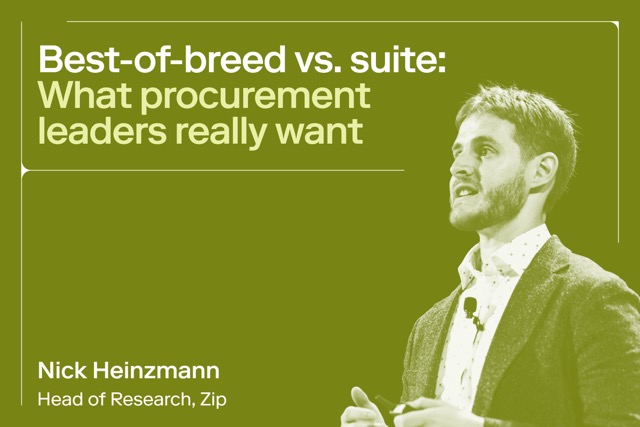
What is intake-to-procure? Definition and benefits
Capture, manage, and fulfill procurement requests seamlessly from start to finish.

Procurement can get complicated, fast. Between navigating supplier onboarding, ensuring compliance with internal policies, and preventing rogue spend, finance and procurement teams are juggling a lot.
If these headaches sound familiar, intake-to-procure might be the answer.
Intake-to-procure is a modern approach to procurement intake that captures unmanaged spend and guides employees through the purchasing process in a structured, user-friendly way. It integrates with your existing tools to create a single front door for all procurement requests, from purchases and contracts to renewals and supplier onboarding.
Curious how it works and why it matters? Let’s break it down.
What is intake-to-procure?
Intake-to-procure is a centralized, structured process that guides purchase and supplier requests from initial intake all the way through to approval.
It brings consistency, visibility, and automation to the early stages of procurement—before a purchase order is created or a supplier is onboarded.
Before solutions like this existed, procurement was often fragmented and slow. With intake-to-procure, employees have a clear path to follow, approvals are streamlined, and compliance becomes a natural part of the workflow, not an afterthought.
Intake-to-procure vs. intake-to-pay vs. procure-to-pay
These terms can get confusing, but each one represents a different scope in the procurement process:
- Intake-to-procure: The process of capturing, routing, and approving purchase and supplier requests before a PO is created. It sits at the very beginning of the procurement lifecycle.
- Intake-to-pay (I2P): A broader process that spans the full procurement cycle, from intake through to payment. It includes everything from initial requests to purchase orders, invoices, and final payments.
- Procure-to-pay (P2P): Covers the downstream execution steps after a request is approved. P2P is where purchase orders are issued, goods or services are received, along with invoicing and completing the payment.
Benefits of an Intake-to-Procure Solution
Procurement teams often already use tools like P2P or contract lifecycle management systems—but usability and adoption are common challenges. When requests need cross-functional approvals, the complexity multiplies.
Without a centralized intake solution, processes remain fragmented.
According to a Zip report based on 1,056 U.S.-based finance and accounting professionals:
- Nearly half of businesses require six or more cross-functional approvals for a new software or supplier purchase.
- 32% say it takes three weeks or longer to secure approval.
- 27.1% say more than 10 approvals are required for some purchases.
By streamlining intake and routing requests efficiently, intake-to-procure solutions increase adoption, improve visibility, and reduce risk—while helping you gain control over more of your spend.
1. Faster employee adoption
With a centralized front door, intake-to-procure ensures every employee knows where to start a procurement request. When the process is simple and easy to follow, adoption naturally increases.
This also gives procurement teams greater visibility into company-wide spend. And when employees feel empowered and informed, they’re more likely to follow policy—driving better compliance across the board.
2. Increased spend under management
Spend under management refers to the portion of company spend that procurement teams actively oversee. The more employees use an intake solution, the more spend comes under control.
Intake-to-procure can increase spend under management by 80% in early use cases—and help companies push past the common ceiling of 60–70% to hit 90% or more. With average savings of 9% for every new dollar under control, the financial impact is significant.
3. Improved operational efficiency
Automated workflows remove the guesswork and manual handoffs that slow down procurement. From request routing to stakeholder notifications, intake-to-procure solutions keep the process moving.
Nearly every aspect of the process happens in one place—supplier onboarding, approval routing, IT and security checks, legal review. No more chasing down approvals in email threads.
But don’t take our word for it: learn how Patreon reduced approval cycle times by 50% with Zip.
4. Less risk
Risk in procurement can come from all angles: unauthorized contracts, missed security reviews, noncompliant suppliers, or unchecked spending.
Intake-to-procure software helps flag these risks early in the process. Whether it's identifying a supplier that hasn’t passed security review or catching missing legal approvals, the platform gives teams the tools to stay ahead.
5. Controlled spend
Better efficiency and lower risk means better outcomes for your budget. Intake-to-procure solutions automatically route requests to preferred supplier options and enforce purchasing policies from the start.
As Zip’s Head of Research, Nick Heinzmann, puts it: “The earlier you get involved in spending, the more you influence the spend.”
The procurement intake process
Procurement intake is a comprehensive process that includes many repeatable steps. Automated intake-to-procure tools make for smooth and efficient processes.
Implementing an intake-to-procure solution at your company may look something like this:
1. Create a dynamic intake form
An intake form is where it all starts. It should adapt based on the request type—asking for specific info like supplier name, scope of work, ideal timeline, budget, and key stakeholders. This ensures approvals aren’t delayed by missing details.
2. Design a purchase request approval sequence
Approval workflows outline who needs to sign off and when. A well-defined approval sequence ensures transparency and avoids bottlenecks.
3. Pull in the proper stakeholders
Each request might need input from different teams—IT for software, legal for contracts, finance for budget, and so on. Intake software automates stakeholder assignment and keeps everyone aligned with real-time updates and comments.
4. Align your team
When everyone has access to the same system, the process becomes clearer. Intake-to-procure tools create one shared source of truth, so teams can collaborate more effectively.
5. Confirm your launch with executive alignment
Before a purchase moves forward, key decision-makers need to be looped in. Make sure the request has been communicated and explained to the relevant parties:
- Key executives
- Suppliers involved
- Finance team
- Legal team
Intake solutions help formalize this step, so nothing gets missed—and no one is caught off guard.
6. Monitor for risks and roadblocks
Issues will pop up, so your intake process should help you identify and resolve them early. Automated tracking and compliance checks are critical to preventing problems downstream.
7. Continue to improve
Once a request is completed, take time to evaluate. What went well? What slowed things down? Intake-to-procure platforms provide reporting and summaries that help you refine and optimize over time
Key features of intake-to-procure solutions
For many companies, procurement tends to focus on compliance. The stakeholder user experience of supplier onboarding and procurement intake tends to fall by the wayside, much to the detriment of the company.
Intake-to-procure melds procurement intake, supplier onboarding, and cross-functional approval processes under one streamlined view. Automation provides tangible metrics so that companies can focus on optimizing procurement. It all comes together, providing an incredible experience for everyone.
With an intake-to-procure solution, you get:
A single front door for all procurement requests
A centralized request hub gives employees one place to submit any type of request—whether it’s a new supplier, software contract, purchase, or renewal. This eliminates confusion and boosts adoption.
Collaborative approvals
Built-in visibility and shared progress tracking means fewer blockers. Teams can collaborate in real time and see exactly what’s needed to move a request forward.
P2P and ERP integrations
Seamless integration with your existing systems—like NetSuite—ensures approved requests flow into P2P or ERP tools without rework or manual entry.
Supplier management
A centralized repository for supplier data helps you manage relationships more effectively and maintain accurate records.
Renewal management with automated workflows
Alerts! With complete supplier data, the intake-to-procure tool can send notifications about upcoming renewal deadlines and initiate automated renewal workflows, saving time, money, and headaches.
Spend analytics
With one dedicated tool for procurement, you’ll gain the earliest visibility into both spend and the resulting trends.
With these insights, you can take steps that may lead to reduced cycle times, budget optimizations, supplier consolidations, and other lifecycle efficiencies. With this kind of robust customizable data aggregation, the sky's the limit.
AI-powered workflows
AI makes procurement faster and smarter. Zip AI can extract key information from any document, eliminating manual data entry and heightening accuracy with built-in data integrity checks.
Legal and risk review automation can scan MSAs and audit reports for legal and security reviews in seconds, while AI-powered insights can instantly identify redundancies and other savings opportunities.
Want to see Zip AI in action? Learn more here.
How each department benefits from intake-to-procure
Let’s go deeper, and consider how each department can find value in implementing Intake-to-Procure.
Procurement
Procurement often gets a bad rap for slow approvals or unclear processes. Intake-to-procure changes that narrative—giving employees a fast, transparent way to work with procurement while increasing compliance and control. With more time to focus on strategy, procurement teams can demonstrate greater value.
Finance
When employees sidestep procurement, it creates budget blind spots and audit risks. Intake-to-procure centralizes spend, improves reporting, and gives finance tighter control over budgets and planning.
Explore Zip’s solution for finance.
IT
Software sprawl and shadow IT are real problems. Intake-to-procure brings IT into the process early, helping teams evaluate and approve tools before they become risks. It also improves planning and reduces surprises.
Security
Security teams are often left out until the last minute—when issues are harder to fix. Intake-to-procure automates data collection and reviews, giving security earlier involvement and better visibility.
Legal
Last-minute legal reviews slow everything down. Intake-to-procure loops in legal earlier, streamlining approvals and linking with CLM and GRC systems to manage risk and access legacy contracts.
Learn more about Zip’s legal workflows.
Take control with Zip intake-to-procure solutions
If you’re ready to improve your procurement intake process, Zip offers a best-in-class intake-to-procure platform that helps companies streamline requests, increase adoption, and control spend.
With Zip, employees get a clear, easy way to request purchases and suppliers. The platform routes every request to the right stakeholders at the right time, automatically. And it connects seamlessly with your P2P or ERP system to avoid duplicative work.
Zip gives you visibility across all spend, improves collaboration, and unlocks greater efficiency across departments.
Request a demo to see how Zip can transform your procurement intake experience.

Maximize the ROI of your business spend

Enter your business email to keep reading



























.webp)



















.avif)













.avif)










.webp)





.avif)












.avif)
